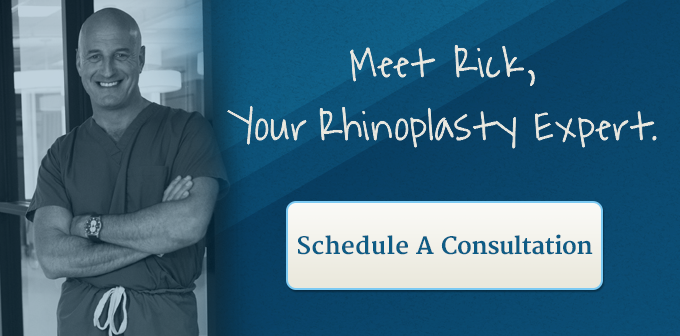When you’re looking for a surgeon who can offer you an excellent revision rhinoplasty result in NJ, you’ll find there are only one or two specialists (in any given area of the country) who qualify. That’s because revision rhinoplasty is one of the more difficult plastic surgery procedures to get right. Some surgeons won’t attempt a revision rhinoplasty surgery. While this can be frustrating to hear, it’s actually helpful because it helps you narrow down your choice of surgeon.
A true revision rhinoplasty specialist can produce consistently attractive and natural results for patients, no matter the type of correction required. I’ve been able to offer significant improvement for the vast majority of patients I see who are seeking corrective rhinoplasty surgery. Here are our tips to ensure you have the best experience and outcome from your secondary rhinoplasty.
1. Look for a rhinoplasty specialist and reconstructive surgeon:
Your chosen surgeon must have the training, board certification, experience, reputation and advanced skills to do the job. Your chosen NJ plastic surgeon must understand and have effective surgical techniques to make almost any change required in a nose and, at the same time, produce a strong result that will stand the test of time. (Look for someone with facial reconstructive experience.)
Besides ensuring that you look great, your surgeon must also improve or preserve your ability to breathe freely. After all, you should never have to repeat your rhinoplasty and you should absolutely never need to repeat your revision! Don’t settle for an average plastic surgeon. Your upfront research in finding a true revision rhinoplasty expert will allow you to go forward confidently and expect a wonderful result from revision rhinoplasty.
2. Find the plastic surgeon with a true passion for revision rhinoplasty:
In almost any field, passion and enthusiasm can be tied to doing your best work. That’s true for surgeons too. Speaking personally, I’m so interested in the opportunity for life improvement (that revision rhinoplasty can bring to patients), that I’ve specialized in taking the most challenging revision surgeries.
I’m passionate about the field and I have a long history of performing reconstructive surgery, so repairing even the tougher cases in revision rhinoplasty falls well within my skill set. Plastic surgery is more than a career for me, it’s really a calling. My active interest in corrective nasal surgery is one of the reasons I can produce consistently terrific revision rhinoplasty results. Remember, passion for improving lives is important at this level of surgical specialization.
3. Keep the boards straight:
The most accomplished, best-qualified plastic surgeons are board certified in that field by the ABPS (American Board of Plastic Surgery). This organization has pushed the standards of education, training, patient safety and ethical accountability in the profession to higher and higher levels.
Surgeons hoping to be certified plastic surgeons must have 6 years surgery training (3+ years general surgery and 3+ in plastic surgery specifically) after receiving their medical degree (the MD degree itself, of course, takes 8 years of college). After fulfilling these stringent educational requirements over years of study, surgeons must then pass rigorous comprehensive tests to earn ABPS board certification as a plastic surgeon.
But that’s not all, throughout their careers, to maintain certification, surgeons must stay up to date with the latest science and surgical methods through continuing education. This is crucial because you want the best-prepared, most skillful surgeon to perform your NJ revision rhinoplasty.
4. Ensure understanding of your revision rhinoplasty needs and goals:
Make sure your surgeon examines your nose and face carefully and is able to identify problems with your nose. In addition, your surgeon must ask about and understand what bothers you about your nose. You’ll get some idea of whether you two are on the same page when the surgeon explains to you his or her strategy to accomplish the requested and required changes in your nose. If your surgeon doesn’t explain to you what will happen in surgery, you should be concerned.
5. Do a reality check:
Your surgeon should clearly acknowledge whether the rhinoplasty goal you have in mind (for your revision rhinoplasty result) is possible, given your current starting point after your primary rhinoplasty result. The surgeon may need to work with you to ensure that you have a realistic idea of what is possible and what you can expect from your revision rhinoplasty in NJ. This kind of discussion is vital to ensure you get what you expect from your revision rhinoplasty and enjoy a natural, attractive result.
6. Look at and discuss your surgeon’s portfolio:
The “before and after” photos you’ll see online and at your surgeon’s office should be numerous and clearly not stock photos or retouched photos. Having a large number of attractive after shots makes it very likely that you’re looking at genuine photos.
Look for photos that might share characteristics with your nose. Ask your surgeon to specifically show revision cases, not primary cases. Remember that your case will be truly unique, so you can’t expect the exact same results of a particular past patient you see. Still, the portfolio can give you an idea of your revision rhinoplasty surgeon’s sense of aesthetics and their abilities. You can also ask to speak with a prior patient.
7. Talk about any breathing problems:
There may be lots of detail involved in expressing how you would like your nose to look, but make sure you inform your surgeon about any breathing problems as well. You may have a deviated septum that was never properly addressed by your primary rhinoplasty surgeon, which might be affecting your breathing.
It sometimes occurs that your nose was rendered too narrow at the bridge for proper breathing. In other cases, part of your nose may have collapsed after your first surgery if your primary surgeon did not properly shore up and strengthen your nasal structure. Your plastic surgeon is trained not just to change and correct the look of your nose, he or she must also ensure the result allows your nose to function properly.
8. Learn about costs for revision rhinoplasty in NJ:
Your NJ rhinoplasty surgeon should be able to outline your costs for the entire procedure so that you won’t have any surprises. Make sure the grand total you are given includes anesthesia and surgery center costs. Ask if all follow-up visits are included.
9. Know the terms involved in revision rhinoplasty:
Your surgeon will explain your procedure in detail, but here are just a few common terms to get you started:
- Septoplasty: Correcting a deviated septum.
- Deviated Septum: This can be present at birth or caused by an accident. Describes a situation where the thin dividing wall (cartilage) between your nostrils is crooked, which may or may not make your nose look crooked on the outside. If moderate to severe, it may cause you symptoms like breathing difficulty, nasal congestion and nose bleeds.
- Columella: The strip of skin dividing the nostrils at the bottom of the nose. Also commonly spelled columnella.
- Open rhinoplasty: Surgical method involving an incision across the columella, allowing the surgeon to most clearly visualize and access the nasal structures.
- Closed rhinoplasty: Rhinoplasty method (also referred to as endonasal) where the surgeon places incisions inside the nose only. This allows limited visualization of the surgical area.
- Cartilage graft: This is often needed in revision rhinoplasty in order to build up, rebuild or strengthen the tip or bridge of the nose. Graft material is typically autologous, or taken from your own body. The graft is often taken from your septum or ear.
- Osteotomy: Procedure where bone is cut to shorten or realign it when reshaping the nose.
- Dorsum: The upper (bony) and middle (cartilage) section of the nose, also called the bridge.
- Ala: The side of the nostril.
- Lobule: Nasal tip.
- Turbinates: Bones that baffle (restrain or direct) air flowing into the nose. Covered over with mucous membranes, turbinates help to warm, moisturize and filter incoming air.
- Secondary rhinoplasty: Revision rhinoplasty or a corrective nose job.
- Tertiary rhinoplasty: The surgery you will never need to have.
10. Get started today:
If you’ve been unhappy with the results of your initial rhinoplasty and would like to see a different surgeon to correct the problems you’re having, contact the experts at Cohen/Winters Plastic & Reconstructive Surgery in Bergen County, NJ. Schedule your detailed consultation today to learn about specific revision rhinoplasty options, tailored to your needs. Contact us today.


